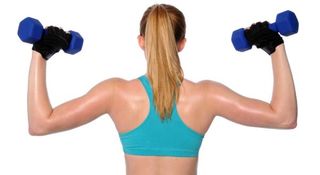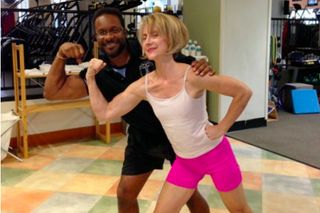
What — and When — to Eat to Build Muscle (Op-Ed)

Katherine Tallmadge, M.A.,R.D., is a registered dietitian, author of "Diet Simple: 195 Mental Tricks, Substitutions, Habits & Inspirations" (LifeLine Press, 2011) and a frequent national commentator on nutrition topics. This article is adapted from one that first appeared in the Washington Post. Tallmadge contributed this article to LiveScience's Expert Voices: Op-Ed & Insights.
One of my 50-something clients recently lost 20 pounds through a combination of a few nutrition, eating and behavior modification tricks I provided to her, along with her increased pedometer steps and added weight training.
Afterward, she confided in me that she feels sexy for the first time in years! On the tennis court, she performs better and is more flexible, stronger and quicker. Who could ask for more in your 50s — or 40s, 60s and beyond?
To get results like these, weight training is key. My clients regularly ask me, "How do I maximize my workouts to gain muscle as quickly and effectively as possible?"
My answer: What you eat and when you eat it profoundly improves your ability to build muscle mass and strength, and new surprising studies show an ancient beverage — and an ancient exercise — can make a huge difference, too. Let me explain.
Your workout
While nutrition is important, the quality of your strength-training workout is a key factor for building muscle mass. The American College of Sports Medicine recommends doing strength training for all of your major muscle groups at least twice a week. I encourage all my clients to get some kind of strength training so that when they lose weight, they not only look more toned and have more strength (who wants to be a flabby skinny person?), they're also healthier. You can do this by working with a skilled trainer, but also through vigorous yoga, Pilates and even swimming. Whenever there is resistance and you work your muscles to exhaustion, such as when you can't do just one more pushup, you're building muscle.
Sign up for the Live Science daily newsletter now
Get the world’s most fascinating discoveries delivered straight to your inbox.
And getting stronger comes with more healthy benefits. The more lean muscle you have, the more calories your body burns. In other words, muscle mass increases metabolism. That's why a man who weighs the same as a woman can eat so much more, and will lose weight more easily. He has relatively more muscle, so he burns more calories — even at rest!
For seniors, strength training can make big quality-of-life improvements. Studies of 80-year-olds show muscular strength can mean the difference between independence and a nursing home: it improves balance and walking ability, while reducing the risk of falls.
But, for a variety of reasons, it's not easy to build muscle.
First, muscle mass declines as you age, starting in your 30s. An average person will lose 5 to 7 pounds of muscle between ages 35 and 50 due to disuse. For every pound of muscle lost, you lose the capacity to burn 35 to 50 calories per day. That means, if you've lost 7 pounds of muscle by the age of 50, at 50 calories per muscle, that's 350 calories you need to avoid every day just to prevent weight gain, let alone lose weight.
Second, weight loss causes muscle loss. When you lose weight, about half of what you lose is muscle — though you can minimize muscle loss by eating right (so read on!). This makes it even harder to keep the weight off, because you're reducing your muscle, and therefore your metabolism, as you lose pounds.
This brings us to the obvious: Building muscle as you age, eating the right kinds of foods to make that happen — and to minimize muscle loss as you lose weight — is essential to staying lean.

Now for the nutrition...
Protein
Protein is essential for healthy living. It is one of the most important nutrients for the human body, second only to water. Bone health, muscle function, muscle strength, muscle mass and immune function — all are impaired with a low intake of protein.
New research has found that eating the right amount of protein —and at the right times — is essential not only for your general health, but also for effective muscle gain and weight loss. Eating enough protein while losing weight is more likely to minimize muscle loss and maximize fat loss. Keeping muscle stores high is critical, because when you lose muscle, it decreases your resting metabolic rate, making it harder to maintain a healthy weight or lose body fat.
The National Academy of Sciences, in a recent report, recommended Americans get at least 15 percent of their calories from protein, but never exceed 35 percent. At that point, adverse symptoms begin to appear. (Low carb diets are often as high as 80 percent protein, and can damage your health in many ways.)
If you're losing weight or are worried about muscle or bone loss, consider increasing your protein.
How much protein?
A personalized formula: Studies of aging populations have found that about 1.2 grams to 1.6 grams of protein per one kilogram of body weight helps to reduce age-related muscle and bone loss. This amount should also be enough to maximize your workouts. (Determine your ideal body weight.)
Example: If you weigh 150 pounds, this means the amount of protein you should eat is: 150 lbs (divided by 2.2 lbs per kilogram) = 68 kg; 68 kg x 1.2 grams of protein per kg of body weight = 82 grams of protein daily. For the maximum amount of protein, multiply 68 kg x 1.6 grams of protein per kg = 109 grams of protein per day.
Where should you get protein?
Protein can be found in a wide range of foods. Animal protein is in seafood, dairy products, meat, poultry and eggs. Vegetarian protein can be found in legumes, soy, vegetables and grains. And while it's true that high-protein foods often bring fat and calories along as uninvited guests, it doesn't have to be that way. The lowest-calorie animal protein sources are the leanest. Go for seafood, poultry with no skin, lean veal cuts, pork tenderloin, lean beef cuts (such as the round or tenderloin), or 95-percent-lean hams (less than 3 grams of fat per ounce). Skim milk, nonfat yogurt and low-fat cheeses are also great options. Soy products provide great low-calorie options, too, and are high-quality proteins that are lean substitutes for meat.
To add some protein to your diet, toss four ounces (120 grams) of lean beef, chicken or seafood or 12 ounces (36 grams) of spiced tofu into your salad. This will add 30 grams of high-quality protein and no more than 150 to 200 calories.

Here are the numbers for some other great sources of protein:
8 ounces milk or yogurt: 8 – 16 grams protein, depending on the type 1/2 cup cooked beans or tofu: 8 grams protein 1 ounce meat/fish/chicken/cheese (the leaner the meat, the more protein and the fewer calories): 7 grams protein 1 large egg: 7 grams protein 1/2 cup cooked or one ounce dry (1 slice bread) grain: 3 grams protein 1/2 cup cooked or one cup raw vegetables: 2 grams protein
Timing is everything!
Eat a food or beverage high in protein about 20 minutes before, and again immediately after, your strength-training workout. And do the same after a vigorous cardiovascular workout, such as tennis or kayaking, or even just a long walk. When you work out, you break down your muscles. Taking in a high protein food — with a little bit of carbohydrate and nutrients — when your muscles are being broken down by exercise will build your muscle mass and your strength more effectively. And don't forget to drink water, because you also need to make sure you hydrate yourself properly!
My personal regimen includes drinking some skim milk before my workout (all you need is about 1/2 a cup, or about 4 grams of protein) and eating yogurt immediately after my workout or yoga session — in the gym! If I forget the yogurt, I'll run to the nearest coffee shop after I exercise and buy a skim latte, which contains milk — or soy milk — for my protein. But I like yogurt the best: In addition to high-quality protein, it contains important probiotics which keep your gastrointestinal tract healthy. It also offers high-quality carbohydrates, calcium, potassium and magnesium — important nutrients that you need to replenish your muscles.
Current thinking among protein researchers is that this nutrient is more bioavailable for your muscles if eaten in relatively small quantities throughout the day. For women, 20 grams per meal is the ideal amount the body can utilize efficiently. For men, that can go up to 30 grams per meal. So, with my personal protein-goal of 60 grams per day, I make sure to have about 20 grams in the morning, 20 grams mid-day and about 20 grams in the evening. My body may not benefit from taking in more than that at one sitting.
If you're a man who needs 100 grams per day, you could spread out your protein intake for the day to four meals of about 25 grams each — separated by at least two hours in between. So an 8-ounce steak at night, containing 56 grams of protein, just won't cut it!
Surprise … Tea!
A new study has found that tea improves muscular strength. Tea? Apparently, as people age, oxidative stress and inflammation cause age-related breakdowns of muscle and bone. Tea's healthy compounds, called "polyphenols," reduce oxidative stress and inflammation, preventing this breakdown, and even improving muscular strength and bone mass. A recent study funded by the National Institutes of Health's National Center for Complementary and Alternative Medicine looked into tea's effects on muscle. In the study, post-menopausal women with osteopenia (the beginning of osteoporosis, or brittle bones) were given tea or performed Tai Chi exercises. After six months, the tea alone caused an improvement in muscle strength and bone-building biomarkers. (You can learn more about the health benefits of tea here.) Tai Chi alone — certainly not the rigorous or impactful exercise that researchers understand is necessary for muscle and bone building — also helped. Apparently, Tai Chi reduces inflammation and oxidative stress, too.
With the amazing results of that study in mind, it makes sense that any foods high in anti-oxidants and anti-inflammatory compounds, such as fruits and vegetables, may help improve bone and muscle strength. And, if Tai Chi helps improve bone and muscle mass, shouldn't other forms of meditation or meditative exercise, such as yoga, do the same? More research is needed to establish these links, but the results certainly are promising.

In the meantime, I'm drinking tea every day, doing vigorous yoga at least 2 to 3 times a week, working with a trainer once a week, walking a lot to keep body fat down (at least 10,000 pedometer steps is my daily average), eating plenty of yogurt and cooking batch recipes from my books. All of this helps keep my muscles and bones strong, and my body in shape.
Tallmadge's most recent Op-Ed was "Why Childhood Obesity Drop May Herald a Change of Habit,"and her additional contributions are available on her profile page. Her latest book is "Diet Simple Farm to Table Recipes: 50 New Reasons to Cook In Season." You can follow Tallmadge on Facebook, Twitter @KETallmadge and on YouTube. The views expressed are those of the author and do not necessarily reflect the views of the publisher. This article was originally published on LiveScience.com.
Most Popular


